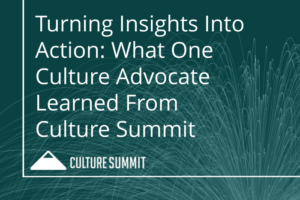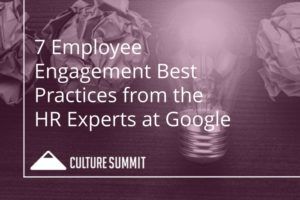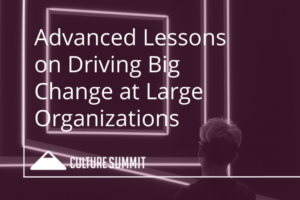Turning Insights Into Action: What One Culture Advocate Learned From Culture Summit
Alicia Case began her advertising career as a copywriter on the client-facing creative side, working on branding, ad concepts and creative for large health and wellness brands including Procter & Gamble Global Oral Care and Pfizer Women’s Health. Over time, it became more and more clear that she wanted to help spread her team’s thriving team culture to the rest of the organization.
Case began to wonder, “How do we establish an ownable, differentiating culture across our the entire organization that makes people want to stay working here and attract outsiders to come here?”
With that question, Case cultivated a cultural overhaul to the entire agency setting the path directed to an employee-facing role that now made her “client” the agency she worked for. After more than a year of developing this robust culture program and showing positive results from annual surveys and increased employee satisfaction, Case proposed a new role and officially shifted her career path. She moved from the creative side to a role focused on a wider set of employee culture variables including internal communications, social media, events, recruiting, reward and recognition opportunities, and more.
Throughout all this change and growth, Case has used her background in creative advertising to think about building culture the same way you would build a good brand, and attending Culture Summit for the past two years has been an important milestone in Case’s development as a culture and employee experience professional. Each year has featured keynotes, speakers, and presentations that helped her shape her understanding of culture and build an intentional employee experience at Publicis Health.
“Our agencies want to emulate many of the characteristics of Facebook, Amazon, Google, LinkedIn, Spotify, etc.,” says Case. “And for me, it’s important to not just understand what they do outside of their organizations but also on the inside.”
“What are they doing to create cultures and employee experiences that get their people to put out the caliber of work that we admire and recognize as best in class?” Case continues. “How are they building an employee experience that’s directly linked to the company ROI? That’s why it’s imperative to attend conferences like Culture Summit because you get to go under the hood of companies you may not otherwise get to hear from.”
Here are some of the most important Culture Summit takeaways she’s collected over the years:
 Photo Credit: Cathryn Lynne Photo
Photo Credit: Cathryn Lynne Photo
1. Culture is a combination of micro and macro experiences
From the application and interview process to onboarding, training, and working on day-to-day tasks, the employee experience is made up of a number of different large and small employee experiences. When you look at how your organization builds its culture, consider high-level macro, big things you do that affect the entire organization as well as the small micro-level individualized factors. Which brings us to the first point Case would like to emphasize: culture is not some distant concept developed by the higher-ups like a product to be passed down. It’s every single micro and macro interaction a company has with its employees…
- It’s our competitive advantage for recruitment and retention
- It’s why we want to work here and also stay working here
- It’s what can drive engagement, which increases output and makes our clients happier as a result because more engaged people means a higher quality of work, which means happier clients, which means more money back into the business
Micro experiences look at what individual things are happening at a granular level for each employee, like learning and development, career mobility and development, rewards and recognition, diversity and inclusion initiatives, and thought leadership opportunities. Macro experiences include the things that impact every single employee at large, like the company mission, brand values, processes, benefits, physical space, technology and tools, communications, etc. A successful culture will intentionally establish and adjust both macro and micro experiences to the needs of its people. A culture that can be responsive to its people’s needs will thrive.
Key Takeaway: Give more personalized gifts instead of giving everyone the same gift card or spot bonus. If you know a team member loves music or they’re a foodie, why not give them a pair of concert tickets or a dinner at a Michelin Star rated restaurant? Those small details make the person feel like the organization “gets” them. It’s building on a total rewards philosophy and moving away from the thinking the same things work for everyone.

Case (center) speaking on the “Power of Business Resource Groups” panel at Saatchi & Saatchi. Image Source: Kipp Jarecke-Cheng
2. If you want to emulate the pros, learn from them
According to Case, one of the best parts of the Culture Summit was learning from relevant, best-in-class brands like Facebook, Google, and LinkedIn. Many legacy companies that have been around for decades or over a century are looking to change their business models to meet today’s business demands, many of which are being driven by these tech titans. These company’s outputs are a reflection of what’s happening inside and the culture and talent that’s there, it offers a great learning opportunity for brands that want to achieve that kind of success on their own. Or a minimum, understand how they’ve created a culture that is writing the playbook on today vs chasing to keep up.
“One of the most memorable panels was one about diversity and inclusion, but how Airbnb put the emphasis on belonging versus inclusion was the real differentiator,” says Case. “When you’re a visitor staying in a host’s home on Airbnb, you want to feel like you belong there. It’s totally different from a hotel. Staying in someone’s home you truly need to create a sense of belonging. That the people hosting want you there, they make you feel at home, they make you feel comfortable with the city you’re visiting, you feel like a local vs just a tourist.”
“That’s what Airbnb wants to create and to bring this same notion of belonging into how they view inclusion feels so on brand,” continues Case. “They want people to feel like they are truly at home at Airbnb and are connected and really part of the neighborhood. I loved how that nuance came to life not just in what they are doing externally, but internally as well.”
Key Takeaway: So many companies get lost in thinking about what they want to be versus analyzing what they fundamentally already are. Case noted that the Facebook speakers have made excellent points that when you choose a value, you have to think about what you also give up since a value comes at a cost. If you value one thing, there’s something that you don’t value because it’s not possible to value everything: You can’t say you’re funny but also be serious. You can’t say you’re type-A but also be OK with failure. They aren’t mutually exclusive.

Case (far right) attending the Out & Equal Workplace Summit in Philadelphia with the LGBTQ business resource group she co-chairs. Photo Credit: Kipp Jarecke-Cheng
3. Culture needs to be original – not duplicated and not lip service
Another important speaker takeaway for Case was that you can’t say you believe in diversity and inclusion and not have your staff speak truth on its own or not have programs and initiatives that actually help move the needle. The speakers really modeled what they preached and didn’t just make it words. Speakers don’t just tell you they believe in something, they show you how the brand puts those values into practice.
One way Case’s company is following through on this takeaway is to adopt a philosophy to only use real photos from real events – not stock photos or pure type that anyone could use – for the work that their communications department creates. They know it’s important to show their people volunteering their time painting local high schools, dancing in drag pageants, speaking on panels, or leading a workshop to reinforce who we are and what we stand for.

Amir Diwane performing as Addy Rall in the Publicis Égalité Employee Charity Drag Pageant that Case organizes each year for PRIDE. Photo Credit: Kipp Jarecke-Cheng
Here are a few examples of year-round or ongoing culture initiatives at Publicis:
- To improve presentation skills, one of the agencies selected employees for an offsite “Art of Improv” training. Employees were invited to an offsite event space with stimulating art and colors for a sensory experience in which they worked with an improv company to learn how to think on their feet and be able to change directions quickly if something happens in a presentation.

Agency members participate in an interaction workshop to learn improv techniques that they can apply to their presentation skills. Photo Credit: Alicia Case
- When a team came back from SXSW, they put on a pop-up experience for those in the office who couldn’t attend. To mimic almost frenetic energy of SXSW, attendees needed to make decisions about which sessions to attend happening simultaneously. Additionally, large-scale keynotes were being held in large cafe space while other speakers were presenting in the other conference rooms. At the close of the learning session, there was had a big party with food trucks and a live band to create the same experience as if everyone had been able to head down to Austin, TX.

Agency attendees sit in the cafe and listen to the live band during the SXSW-inspired pop up. Photo Credit: Alicia Case
- For Women’s History Month, employees were asked to nominate a woman in the organization who they thought rocked through Publicis Health’s #WMNLDRSRCK campaign. Nominated women from across the organization were featured on social channels, creating a positive social media footprint with just a bit of coordination and branding work.

Case featured in the WMNLDRSRCK campaign. Photo Credit: Kipp Jarecke-Cheng
Key Takeaway: If you’re doing it right, your company culture will not look like any other company’s culture. Your values, events, and initiatives will be unique and customized to the people who work there. Anything less runs the risk of feeling like lip service to employees who are hungry for a unique company culture that represents who they really are and what they really do.




